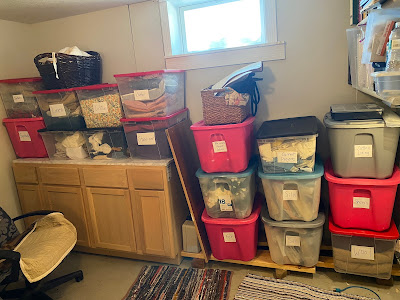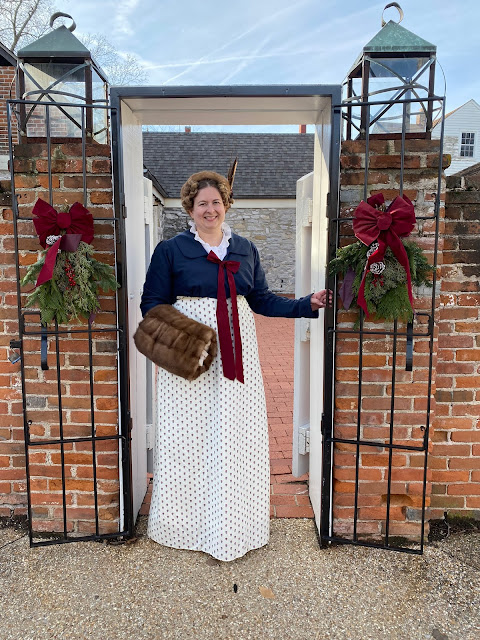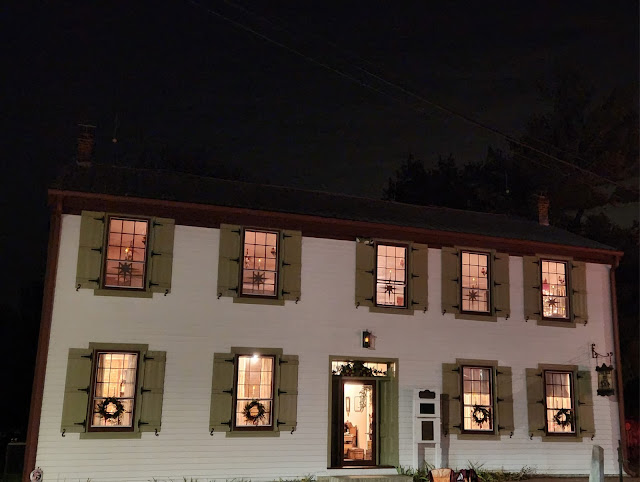Oops behind again, this seems to be a perpetual theme... I had wanted to post this in December yet! It was an extremely happy month of exposure to historical homes looking their very best in all their holiday trappings, so I'm taking the time to fully document it for myself to look back on.
My sweet friend Justine of Early American persuaded me to go down to Ste. Genevieve to do a couple of house tours and hang out for the day, and then in turn, she came across the river to tour the Pierre Menard home, the last true remnant of French Kaskaskia (because the rest got washed away by the Mississippi by the mid 1800s). It's been a true delight visiting, and it turns out our significant others get along very well -- in fact we are going to a dance this weekend!

We started at her friend's store in a historic house, full of adorable Early American and primitive-style home decor (and tinned tea, and Christmas ornaments... with enough money I would have bought out the whole store). After a quick mosey to the town's adorable small post office and a stop at Quintessential Rivertown Tea for a delightful hot cup, we headed over to the Centre for French Colonial Life and looked at the many French artifacts in the museum before we were taken just down the street to the house tours, with the Bolduc House (c. 1788) being the first. I know from descriptions of the historic French homes on the Illinois side of the river that they were often little 1 or 2 room shingled/thatched plastered and whitewashed homes that have semi-medieval French roots, but it's delightful to see them with period furnishings like the one below. Families were generally crammed into one room at night, so beds with curtains you could pull shut were essential for privacy. A second larger room was then added to the house later

A second larger room was then added to the house later, with more room for socializing.
This beautiful armoire, stained by flood water at the bottom (always a threat in this riverine area) is a locally crafted piece of 18thc furniture, and the guide was explaining the stylistic differences between it and Canadian-made or French-made pieces.
I certainly would have liked to take it home with me!

This middle room, barely larger than a wide hallway, was the owner's "office" from which he conducted most of his business dealings. The bench on the far right folds down to reveal a bed!
The tour moved immediately next door to the Bolduc-LeMeilleur House (c.1820) and Justine and I loved the color scheme... soft ivory and a light greyish-green.
This house was considerably less cramped than the older, previous one, so yes I think I could settle in here quite well, haha.
I think Justine said her fiance Ron actually made the replica table in the dining room. He does early furniture-making and painting. While this house and its rooms aren't lavish, they're plenty comfortable, and it's easy to imagine living in them even today, as opposed to the much earlier-style home we first visited.
Wrapping up this tour, we then headed a couple blocks over to the Felix Vallé house, which is run by the State of Missouri. It was built roughly 1818 and they keep it furnished in the style of the 1830s. It has a small general store out of which they did business at the front, and then several rooms much more ornate than the first couple houses we saw:
The small outbuilding to the back was used as a laundry room and bathing room, and I found the rusticity of its colors very charming:

I feel it's vital to note that French Colonial prosperity, though bolstered by the independent fur traders, craftsmen, and farmers, owed a chunk of its success to enslaved labor. Ste. Genevieve (and other French colonial sites) are only getting started on the necessary research for bringing to light the historically ignored contingent of Africans (roughly a third of the population in the area) who were brought in for work in the houses, the gardens, and the fields. Most of their cabins have been pushed over on the historic properties, and not yet excavated or reconstructed, so I'm looking forward to seeing the progress that appears to be in the works to show a sliver of their lives. There were also a few free people of color who owned houses in town in the early 19thc, some of which are still standing, a great educational opportunity that I hope will be expanded on.
In the back courtyard of another set of historic buildings, we took advantage of a perfect little entryway:
...visited the local pewter shop where I lost my cap feathers to a VERY curious and very large kitty (so handsome)...
...and peeked inside the imposing brick Catholic church, built in 1880.
We wrapped up our visit with lunch at "The Old Brick House," a restaurant that claims to be the oldest brick building west of the Mississippi River, built in 1780.
The very next day volunteered down at Fort de Chartres together in the store for a Colonial Christmas market! The store was frequently packed with people and the artisans were pleased with their sales. I picked up candles, ornaments, evergreen arrangements, heirloom seed packets, and more for Christmas gifts that turned out to be very appreciated by the recipients.
A couple weekends later (I think?) we met up again down at the Pierre Menard home -- this house is such a historically important building for the area, and yet the state of Illinois has been, as usual, neglecting it. Fortunately, it FINALLY has a much-needed new roof, so I'm hopeful other repairs will be done soon to keep it standing and in good shape. I didn't take an outside photo so I'm using an old one:
We started in the detached kitchen (built that way so it was less easy for fire to spread to the main house, to which it was connected by a breezeway) where Michell had it nice and cozy, with cider and cake for visitors.
They also had the old smokehouse open, so we admired the hand-hewn beams going up forever.
Inside the home, Justine and I lost our minds over the silk Regency-era gown in the dresser, worn by one of the Menard girls for her wedding and an occasion where she danced with Lafayette. Sadly it's in need of serious restoration and the silk is quite shattered.
This house is quite a treasure of French colonial architecture (built in 1802-3), and hopefully will be standing for a long time. Its signage and basement museum also need some major updating to include the rest of the site's occupants - up to 22 enslaved workers by 1830, and further archaeological work to locate their lodgings (probably on the south-east side of the house, from previous exploratory digs).
I parted ways with Justine for the day, and went from here to the Peterstown House up north, in my hometown, where they were having candlelight holiday tours. Despite living in the town for most of my life, I'd never been in... probably because until recently the place has been kind of a dump-site for everyone's 'oldey-timey' junk in the most disorganized, Cracker Barrel fashion, but it has some younger, more passionate historical society members now who are doing their best to restore the house to its original state, little by little. It was built somewhere between 1800 and 1830 (the left half of the house most definitely older, so it was added onto by 1830) and became a tavern, general store, and stagecoach stop with a large upstairs that was slept in, en masse, by unfussy travelers, until they picked up the next leg of their journey by coach. Eventually it was chopped up into different rooms for use as a boarding house around 1900, and once it was rescued from demolition in 1973, they've been trying to restore it ever since.
(That mannequin HAS to go)
This is probably the oldest part of the building -- the society president said they are hoping to have some dendrochronology done on the exposed wood and it's possible this room was erected even pre-1800.
There's still quite a bit of random county memorabilia in here -- some of it very cool, some of it not particularly historically pertinent (read: old junk handed down by relatives probably not even from this town), but I had such an enjoyable chat with the house's society president, Andrew, that he urged me to join to be a part of volunteering here. They're also working with master gardeners to transform the yard outside to a historically-accurate garden to the early 1800s, so I'm looking forward to seeing that. I will probably end up doing some weekend volunteering once they re-open in the spring; between staffing the Fort store and hopefully being at the Peterstown house, I anticipate needing to sew more historical clothes!
Hope you enjoyed this little sliver of historical holiday homes -- it was a very happy time for me to spend immersed in some delightful architecture, walking where so many have lived before.
































































